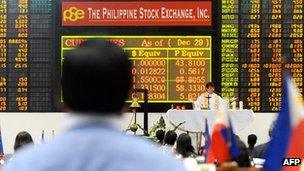Philippines growth beats forecast as it defies trend
- Published

Like other regional markets Philippine stock market has seen high volatility in recent days
The Philippines has posted better-than-forecast economic growth, fuelled by its services sector and higher consumer and government spending.
Its economy grew 7.5% in the April to June quarter, from a year earlier.
It is the fourth quarter in a row its economy has expanded by more than 7% - defying a regional trend which has seen growth slow down in many countries.
However, the country has been hurt in recent weeks by investors pulling out of the region's emerging economies.
The pull out, which has also hurt stock markets and currencies in countries such as India, Indonesia and Thailand, has been triggered by speculation that the US central bank may start to "taper" its quantitative easing programme as soon as next month.
The measure has been used by the US central bank to increase liquidity in the US economy.
'Anchor market confidence'
A part of that liquidity has flowed into Asian markets.
However, the Federal Reserve has said it will scale back the programme if the US economy improves, prompting many investors to pull out money from markets such as the Philippines.
That has resulted in the Philippine currency, peso, falling nearly 10% against the US dollar since May this year.
Meanwhile, the Philippine Stock Exchange Index slid to an eight-month low this week.
However, the country's central bank said that the latest growth data should help lift investor morale
"Solid domestic demand should help counter possible negative pressures from global developments," said Amando Tetangco, the governor of the Philippine central bank.
"Hopefully this performance would help further anchor market confidence, and therewith support the local foreign exchange and stock markets."
He added the central bank will "continue to calibrate its policy levers to help ensure that this robust growth is sustained in a non-inflationary environment".
- Published7 August 2013
- Published24 July 2013